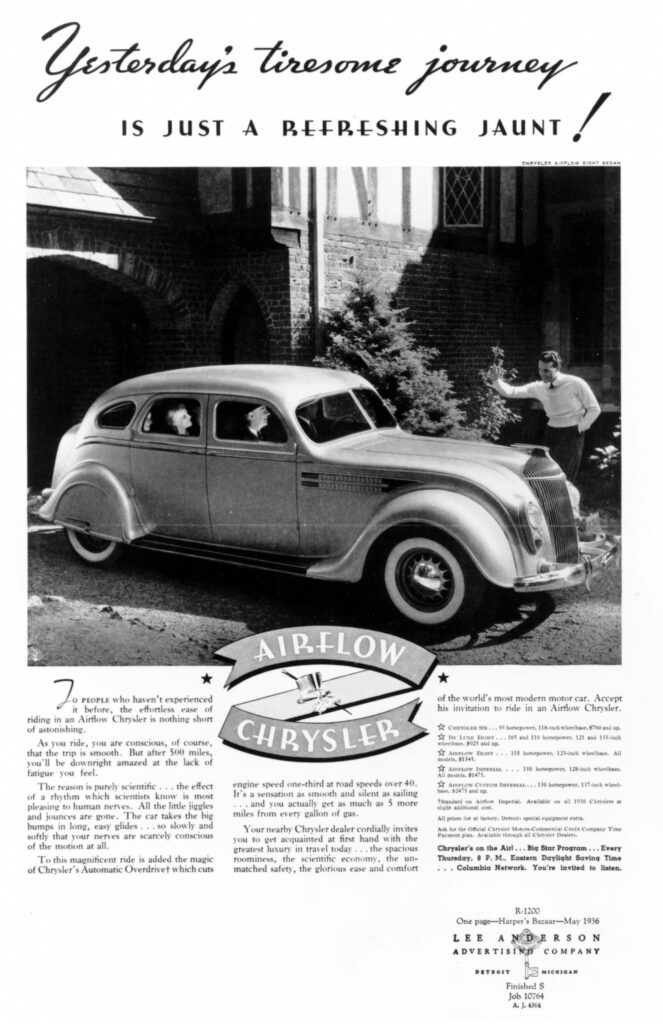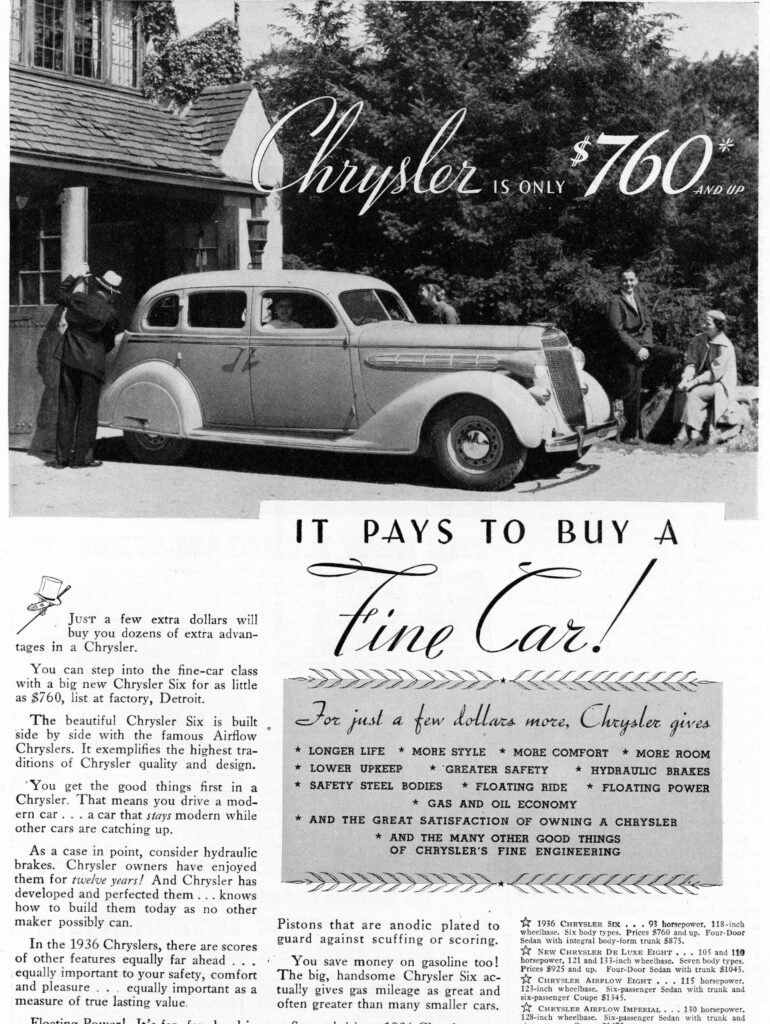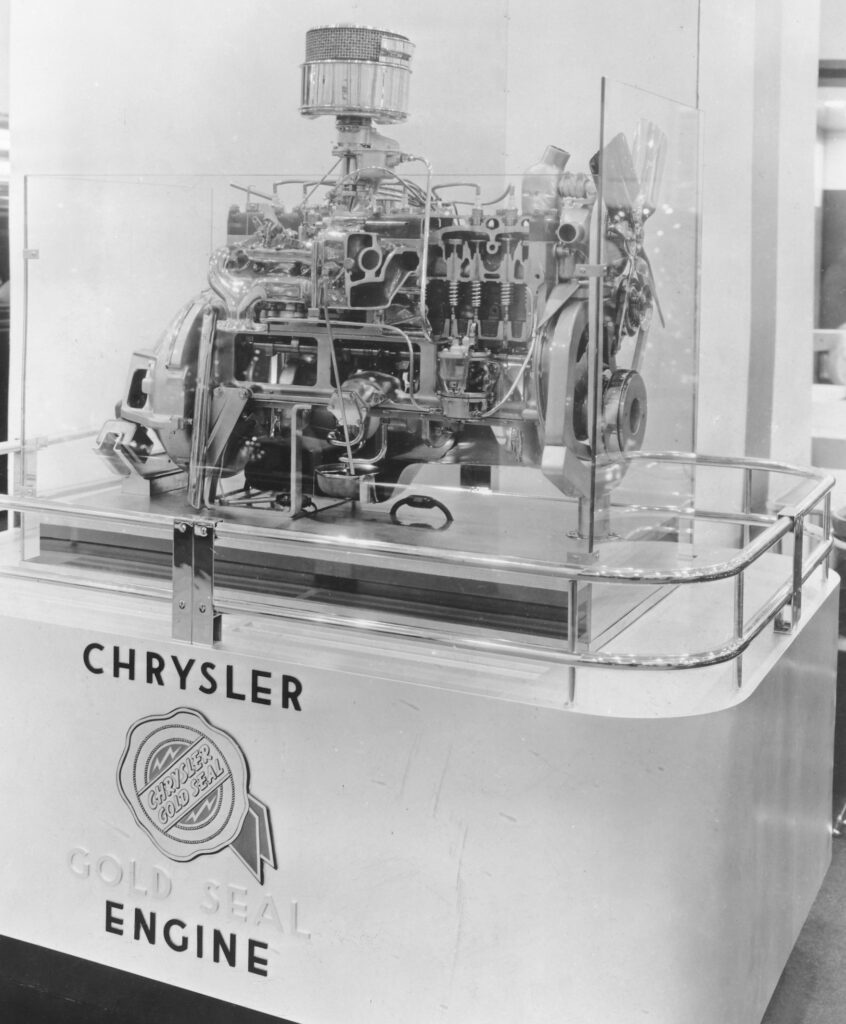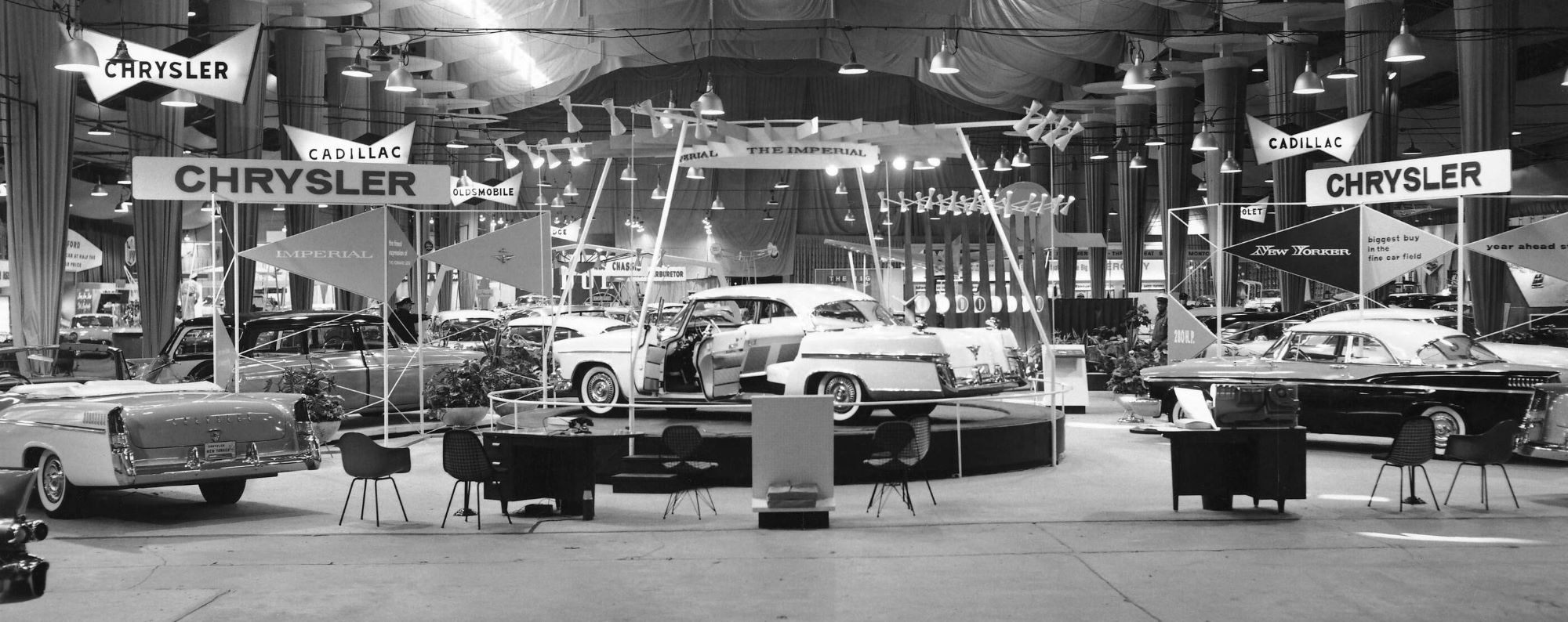
1875-1912
Kansas-born Walter Chrysler, son of a locomotive engineer, was connected to the transportation industries throughout his life. His love of machinery prompted him to forsake a college education for a machinist’s apprenticeship, and his early career comprised numerous mechanical jobs in the railroad industry.
1912-1920
In 1912, Chrysler joined General Motors as manager of its Buick manufacturing plant, becoming president of the Buick division four years later. After parting ways with GM in 1919, Chrysler began a second career as a “doctor of ailing automakers,” strengthening first Willys-Overland, then the Maxwell Motor Corporation.
1920-1924
Chrysler teamed up with three ex-Studebaker engineers, Fred Zeder, Owen Skelton and Carl Breer, to design a revolutionary new car. They defined what the products of the Chrysler brand would be – affordable “luxury” vehicles known for innovative, top-flight engineering.
1924
The first was the 1924 Chrysler Six, an all-new car priced at $1,565 that featured two significant innovations – a light, powerful, high-compression six-cylinder engine and the first use of four-wheel hydraulic brakes in a moderately priced vehicle. The well-equipped Chrysler Six also featured aluminum pistons, replaceable oil and air filters, full-pressure lubrication, tubular front axles, shock absorbers and indirect interior lighting.
1924: Walter P. Chrysler introduces the 1924 Chrysler Six — one of the most advanced and exciting cars of its day. The Chrysler Six is a quality light car — power in a small package — something no other brand is offering at the time. The vehicle makes maximum use of a high-speed, high-compression engine with incredible power and small displacement — along with other features such as hydraulic brakes. This becomes the first modern automobile at a very moderate price — a revolutionary concept in its day.
1925
After securing a $5,000,000 loan to start production, Chrysler sold over 32,000 units of the Chrysler Six in its first year. The Maxwell company soon had a new name: Chrysler Corporation. In 1925, the firm boasted more than 3,800 dealers, sold over 100,000 cars and ranked fifth in the industry.
1925-1930
Some of Chrysler’s early high-performance, high-style cars startled industry observers and customers alike, but mid-range pricing added value and assured the success of the brand. Model numbers told customers how fast each Chrysler would go; the Chrysler 72, for example, featured an optional “Red-Head” engine for better pickup and hill climbing.
Chryslers would also perform commendably in other period racing venues, winning the 1925 1,000-mile Stock Car Speed Trial at Los Angeles and placing second, third and sixth at the Belgian Twenty-Four Hour Grand Prix of 1928. They also did well in endurance competition, completing a 1926 Kansas City-Denver test at an average speed of 51.8 mph and a 1927 New York-Los Angeles round-trip speed run at an average speed of 40.2 mph.
The 1928 acquisition of Dodge Brothers made Chrysler the third of Detroit’s Big Three automakers — and Walter Chrysler one of the most successful industrialists of his generation.
1925-1933: Chrysler Brand Historical Highlights
Chrysler broadens the model line to four separate series. Imperial emerges as a top-level luxury/performance car. Chrysler accelerates its reputation for technical innovation with a constant flow of advances and improvements. After a respectable debut in the 1925 Le Mans 24-hour endurance race in France, a pair of 1928 Chryslers finish third and fourth overall — a stunning testament to Chrysler’s all-round high-speed performance and stamina, as the Chrysler mid-priced cars keep up with competitors’ pure sporting machines. Jaws drop when the 1931 Chrysler models appear — gracefully athletic with tapered bonnets and a new series of powerful straight-8 engines.
1930-1935
Within a decade of its founding, Chrysler Corporation’s leadership in innovation had earned for it the label of Detroit’s “engineering company.” Chrysler’s list of early automotive “firsts” included Floating Power (a new method of mounting engines to isolate vibration), replaceable oil filters, downdraft carburetors and one-piece curved windshields.
Chrysler entered a higher level of competition with its richly appointed Imperial series. With a custom-built body from LeBaron or Briggs, a 145-inch-wheelbase chassis, a 125-horsepower engine and a price tag of $3,145, a typical Imperial of the early 1930s rivaled a Duesenberg in style, but cost only about a third as much!
In 1934, Chrysler, with advice from Orville Wright, built a wind tunnel to test body shapes that led to the first unit-body, aerodynamic car — the Airflow. The idea came from Carl Breer after he tested conventional car shapes in a wind tunnel and found they registered much less drag “tail first.”
Chrysler’s Airflow “streamliner” was dramatic and ahead of its time — the fluid design and pioneering unit-body construction offered improved handing and passenger comfort in a vehicle unlike any seen before.
The Chrysler Airflow also featured recessed headlights, a low step-up height, a standard in-line eight-cylinder engine, automatic overdrive and good gas mileage (posting 21.4 miles per gallon on a coast-to-coast test trip). Unfortunately for Chrysler, the Airflow was a bit too different for most. Even though its design was soon widely copied, this first truly streamlined car was not a sales success.



1934-1942: Chrysler Brand Historical Highlights
The Chrysler Airflow appears in 1934 as a pure expression of engineering vision. It is a mass-production car designed with the aid of a wind tunnel, and it radically changes vehicle architecture, redefining how automobiles are designed. The Airflow becomes the epitome of the modern car (even though its styling is controversial), and the Airflow’s influence can be seen in other makes around the world thereafter. The more conventional Airstream models follow the next year.
Innovative engineering dominates the following years, with advancements such as the Fluid Drive hydraulic clutch coupled with Vacamatic semi-automatic gear selection that eliminates 95 percent of shifting. The Town & Country quickly catches the public’s eye as the first high-quality “estate” wagon. Walter P. Chrysler dies in 1940 at age 65. When World War II is declared, Chrysler diverts its efforts to produce tanks, trucks, airplanes and other vital material.
1936-1937
Less-than-spectacular sales led to stronger promotion of cars like the $925 DeLuxe Eight over the slow-selling, $1,400 Airflow — and to more conservative Chrysler styling.


1938-1941
A new brand-defining model appeared: the New York Special, soon recast as the richly appointed Chrysler New Yorker. Its longstanding popularity would eventually make it America’s longest-running automobile nameplate (1938-1996).
“Fluid Drive” became known as another of Chrysler’s significant engineering innovations — it was an “almost automatic” transmission that virtually eliminated shifting. Others included Superfinish to reduce wear on contacting metal surfaces and Oilite self-lubricating bearings.
Gaining widespread notice in 1940, the Chrysler Thunderbolt show car was a huge two-seater with a retractable steel roof and streamlined cladding front to rear. Chrysler turned even more heads on Memorial Day that year when its exotic Newport Phaeton, one of only five built by LeBaron, served as pace car at the Indianapolis 500 Mile Race.
The most striking production-model Chrysler of the prewar years was the 1941-42 Town & Country, a “barrelback” sedan expanded into an aerodynamic station wagon and trimmed with ash-and-mahogany side panels – the company’s elegant entry into autobuilding’s “woody” era.
1942-1945
All civilian car production stopped for the duration of World War II. Chrysler was eighth among all manufacturers in producing materials for the war effort.
1946-1954
When peacetime returned, Chrysler and other automakers rushed back into production with new cars retaining many of the solid, reassuring features of the prewar models, such as the ash-and-mahogany trim of the new 1946 Chrysler Town & Country sedans and convertibles that succeed the pre-war T&C station wagons.
While many customers, especially Hollywood stars, loved those postwar “woodies,” many others were ready for a change, not just from the style of Town & Country, but from all “high-and-wide” models that harkened back to prewar styles. But Chrysler stood steadfastly by its tall, stolid cars. Through the early ’50s, it built “comforting” large cars; when Chryslers did eventually get a bit longer and lower, styling visibly trailed most rivals in the market.
The first indication of changing times at Chrysler came with the 1951 development, and enthusiastic reception, of the authoritative, hemispheric-head V-8 engine. The soon-to-be legendary HEMI® combined better combustion, higher compression and lower heat loss to create much more horsepower than previous V-8s. Close behind was the fully automatic Powerflite transmission.
Chrysler then reaffirmed its engineering reputation by commissioning a revolutionary gas turbine engine program. This 20-year campaign to apply an aircraft engine turbine’s smooth power and low maintenance requirements to automobiles became part of the Chrysler brand’s folklore.
In 1949, Chrysler hired Studebaker designer Virgil Exner to head an advanced styling section, a first step toward realigning the company’s design priorities. Exner enlisted the aid of Italian coachbuilder Carrozzeria Ghia to began building a remarkable series of so-called “idea cars,” like the 1951 Chrysler K-310 five-passenger sport coupe, the 1952 C-200, which featured the “gunsight” taillight design later used on Imperials, and the 1953 Chrysler D’Elegance, a three-passenger sport coupe with hand-sewn, black-and-yellow leather upholstery and matching luggage.
The most extraordinary car in this series was the Chrysler Norseman, featuring cantilevered arches to support a roof without “A” pillars, all-aluminum body panels and a power-operated, 12-square-foot panel of glass that slid forward to expose the rear seat to the sky. Shipped to America by Ghia, the Norseman sank to the bottom of the Atlantic Ocean on the ill-fated Italian steamship Andrea Doria.
1946-1954: Chrysler Brand Historical Highlights
In the post-war recuperation, new model introductions are few, but the pace of styling change accelerates rapidly in this period. Mahogany-trimmed Chrysler convertibles and two-door sedans become popular. Innovations continue in the form of many industry firsts such as the fully automatic PowerFlite transmission, Hydraguide power-assisted steering, Airtemp air conditioning and four-wheel disc brakes. In 1951, the Chrysler FirePower engine — quickly dubbed the HEMI for its hemispherically shaped combustion chambers — knocks all the other modern V-8 engines back. On the strength of the HEMI, Chrysler returns to Le Mans as the power for Briggs Cunningham’s specials.
1955-1962
Exner revived Chrysler production car design with the sleek, sculptured Forward Look designs of 1955 that transformed the product line overnight. The Forward Look flagship was the 1955 Chrysler 300, a striking automobile that combined smooth styling with brawny HEMI power. The 300, arguably the first muscle car, became a legend on and off the race track and set records throughout the 1950s, including a 143-mph performance at Daytona Beach.
As the Fifties progressed, Chrysler products began to sprout distinctive tailfins, ostensibly to improve handling and stability above 70 miles per hour. The 1957 Chrysler brand standard-bearer, the 300C, was equipped with a standard 392-cubic-inch, 375-horsepower HEMI, two four-barrel carburetors, a high-output camshaft, Torsion-Aire suspension and the new Torqueflite transmission, making it the fastest, most powerful production car built in America that year and earning it the appellation “beautiful brute.”
Throughout the postwar years, Chrysler engineering leadership paced new styling advances. The company’s engineering “firsts” from that era include the first “safety cushion dashboard,” the famous Chrysler push-button transmission (which became an icon of the ’50s), power steering, torsion-bar suspension and the first practical alternator (introduced in 1960, it proved so successful it became standard equipment just one year later).

1955-1959: Chrysler Brand Historical Highlights
Design chief Virgil Exner throws design back into high gear. The HEMI’s power is boosted across the lineup to an unheard-of 300 horsepower in the new Chrysler 300 for 1955. Chrysler chooses to mark this milestone car’s year-by-year evolution as the famous Letter Series. In 1957, new vehicles premiere with new designs (fins and quad headlamps) and new engineering innovations, making the cars dramatically lower and better handling.
1960-1972: Chrysler Brand Historical Highlights
Every Chrysler except Imperial undergoes a radical reengineering to Unibody construction. This major advance results in bodies with greater structural integrity than the traditional body-on-frame method. Overall design also undergoes great changes in this time period, and again, many innovations in engineering are seen, such as electronic ignition, the AC alternator and Sure-Brake anti-lock brakes. The 1965 Chrysler 300L marks the true end of the original Letter Series cars, though in 1970, Hurst Performance Products and Chrysler collaborate on the 300H (for “Hurst”).
1963-1970
Chrysler entered the second phase of its gas turbine project, completing 50 smartly styled, Ghia-designed prototypes for testing by 200 customers. With its whooshing jet-aircraft sound, distinctive exterior and a space-age interior filled with a massive console, the Chrysler Turbine Car would not be confused with any other vehicle. But the realities of poor mileage [11.5 mpg] and high production costs brought the project to a quiet close.
Chrysler products evolved gracefully through ’60s — fins disappeared, large cars became more refined — and ads for the 1963 New Yorker promised that there were “no junior editions to compromise your investment.” The 1963 Chrysler 300-J maintained the brand’s style-plus-speed image with standard leather interiors, heavy-duty torsion bars and Ram induction manifolds; a special-edition Pace Setter convertible version started the Indianapolis 500.
By 1965, Chrysler sales had increased 65 percent and the brand moved from 11th to ninth place in national rankings. Models ranged from the “affordable luxury” of the Newport line (with no fewer than 376 trim and color combinations), through the high-line New Yorker to the sporty 300 with its 440-cubic-inch V-8 engine.
1971-1979
Following a decade of considerable success, Chrysler made an ill-fated, $450 million investment in new large cars just before the 1973 oil embargo. Public demand quickly turned from traditional large cars to mid-size and smaller vehicles, forcing Chrysler and its competitors to make expensive changes to their product lineups.
One design highlight in Chrysler’s rapidly evolving 1970s lineup was the Cordoba — a 115-inch-wheelbase coupe billed as “Chrysler’s new small car.” With its Jaguar-like front end, formal roofline and one-of-a-kind rectangular taillamps, it became one of the era’s most memorable cars – along with the TV commercials featuring actor Ricardo Montalban extolling the virtues of its “rich Corinthian leather” interior. Cordobas sold better than all other Chrysler models combined, inspiring other new, “smaller” Chrysler designs, like the LeBaron Medallion coupe.
1973-1982: Chrysler Brand Historical Highlights
The Oil Producing Export Countries’ (OPEC) oil embargo hits in October 1973, greatly affecting consumer taste, leading them to prefer compact and imported cars. In 1975, Chrysler responds with the handsome Cordoba, the smallest Chrysler in decades, which outsells nearly all competitors. The Cordoba implements an Electronic Lean Burn System, a very sophisticated technological approach to fuel economy and emissions issues. As the fuel crisis eases, Chrysler sales recover thanks largely to the Cordoba and the new mid-size, even smaller LeBaron.
1980-1987
In 1980, Chrysler — deep in its greatest financial crisis — turned to the all-new K-Car for salvation. While some called it “the metal brick,” in many ways the functional, compact, front-wheel-drive K-Car was just the right car for the times.
This automotive “back to basics” era peaked with the 1984 introduction of the minivan. Chrysler Corporation’s most practical vehicle proved to be its most popular and eventually led to the revival of the Chrysler Town & Country nameplate on an upmarket version.
The design highlight for the Chrysler brand during this period was unquestionably the LeBaron convertible, which reintroduced the convertible to the American market and enjoyed a nine-year run as it brought style and excitement back to the brand.
1983-1992: Chrysler Brand Historical Highlights
The American automotive industry aligns more closely with the worldwide auto industry in terms of production and technology, building vehicles with independent suspension, front-wheel drive and other common features of the time. The gap between American and European automakers shrinks considerably.
Chrysler brings out the new-generation “little” LeBaron offered in a wide array of models, including a convertible. The chic Town & Country station wagon’s popularity leads to the famous nameplate and woodgrain trim being applied to the convertible. The sporty, low-slung Chrysler Laser draws a new, younger generation of buyers to the brand. The LeBaron GTS pushes into the growing Euro-style sport sedan segment, and the two-door LeBaron is radically redesigned for 1987, with the convertible version becoming the first Chrysler in decades to be designed from the ground up as a convertible. A sporty roadster called the TC has a Maserati-modified powertrain. The venerable New Yorker becomes the renamed Fifth Avenue, one of Chrysler’s biggest and most profitable sellers.
In 1990, Chrysler attaches the venerable Town & Country name to a luxurious version of the minivan that had opened a huge new market segment. This becomes the first minivan for the Chrysler brand, whereas the prior models from 1983 forward had been of the Dodge and Plymouth nameplates.
1988-1998
In the late 1980s, new leadership at Chrysler, determined to return the brand to its roots of engineering and design excellence, decided to create an entirely new line of “Euro-Japanese-ethic” cars — and developed platform teams to get the job done quickly and affordably. The new product philosophy was reflected in the development of concept cars like the 1988 Portofino and the 1989 Millenium.
Chrysler’s renaissance began in earnest with the mid-size 1993 Concorde sedan, which was quickly followed by the full-size LHS and Chrysler 300M, the smaller Cirrus sedan, the companion Sebring luxury sports coupe and the separate Sebring convertible, and the next-generation Town & Country minivan.
1993-1999: Chrysler Brand Historical Highlights
With the debut of the cab-forward Concorde in 1993, Chrysler once again explodes to the forefront of the automotive world by changing the essential architecture of the contemporary automobile, just as it had done previously with the Airflow. The following year’s Chrysler LHS wins even wider admiration. The Chrysler Cirrus for 1995 so closely resembles the futuristic concept car of the same name from a few years earlier that it becomes clear that Chrysler had found a way to create cars in a way that no one else could.
Beneath the new designs are new engines, new transmissions and complete new architectures. The all-new Town & Country for 1996 proves that minivans can be stylish and as luxurious as a fine car, while the Chrysler Sebring Coupe and Convertible reopen a long-ignored market for sporty cars with a back seat.
The 1998 Chrysler Concorde continues a “heritage” design theme pioneered by the 1994-1997 LHS, most notably in its dramatic grille. Heritage design is also seen in the introduction of the 1999 Chrysler 300M, which continues the spirit of the legendary 300 Letter Series cars, and the LHS, filled with tasteful, evocative features like white dial gauges and even an analogue clock. In 1999, its 75th year, Chrysler unveils the segment-busting Chrysler PT Cruiser, loaded with innovations and designed with a “modern classic” look.
- In its final form, the LeBaron convertible of 1993-1995 featured a different face, but delivered the same open-air excitement of its predecessors; form still followed function.
- The Chrysler LHS is a full-size luxury four-door sedan powered by a very responsive 214-horsepower, V-6 engine. It’s a 3.5-liter unit with overhead cams, 24 valves and electronic fuel injection.
1998-2000
Since the DaimlerChrysler merger in 1998, still more outstanding Chrysler vehicles have been developed, including the new Chrysler 300C, the PT Cruiser and PT Cruiser convertible, the all-new Sebring sedan and Sebring convertible, the Pacifica crossover, the latest versions of the Town & Country minivan and the Crossfire sports car.
More than 80 years after the creation of the company, each of these vehicles continues to personify Walter P. Chrysler’s original vision for the brand bearing his name: superb engineering, standout design and fun-to-drive performance — all at an affordable price.
2000-2004: Chrysler Brand Historical Highlights
Chrysler PT Cruiser goes on sale beginning in 2000, changing the automotive landscape. The Prowler joins the Chrysler lineup in 2001, as well as the new Sebring Convertible, all-new Sebring Sedan and all-new Voyager and Town & Country minivans. In 2002 the Chrysler 300M Special and new Concorde take the stage, with the LHS being renamed the Concorde Limited. Then the Chrysler product offensive begins, bringing exciting new models to the lineup, such as the Crossfire Coupe and Roadster, Crossfire SRT6 models, PT Cruiser Cabrio and 300C Sedan and Touring.

You must be logged in to post a comment.